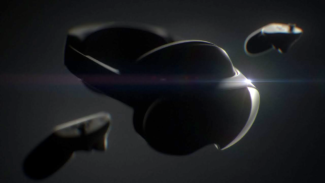Project Cambria is Meta’s next major VR headset release, but what exactly is it? We’ve got all the details we know about the device right here.
Announced back at Connect 2021, Cambria is a different kind of headset for Meta. It’s not focused on massively expanding the VR userbase as seen with the $299 Meta Quest 2, but instead much more focused on providing high-end features to prove out the future of VR in various ways. To that end, we’re expecting a much more expensive device than Quest 2 with some huge new capabilities, due out sometime in 2022. Here’s everything we know about Project Cambria right now.
Project Cambria Is Meta’s Next Standalone VR Headset
First things first: yes, this is another standalone VR headset from Meta. The company has been all-in on the all-in-one category since it ended the Oculus Rift line in 2022 and stated it will no longer make PC VR-exclusive headsets. Instead, everything you’ll need to run VR experiences inside Cambria will already be on-board, just like with Quest. We do expect it to have the same PC VR Link features as Quest, but those are entirely optional.
…But It’s Not A Quest And It’s Not Quest Pro Or Quest 3
Despite being a standalone headset just like Quest, Meta has been very clear that Cambria will not be a part of the Quest line of headsets. Quest is notable for its low price, offering the easiest entry point into VR we’ve yet seen for consumers of all types. But Cambria will be focused on a higher-end market with features that won’t appear in the Quest line for some time yet. It might be a glimpse into the future of the Quest brand, but it’s not a Quest itself and it’s certainly not Quest 3.
And Cambria won’t replace them, either, as Meta executives have stressed on multiple occasions.
It Has New Features Quest 2 Doesn’t Have
To that end, Cambria is stacked with features that are absent from the $299 Quest 2. We’ve listed some of the features we know about below.
High-Resolution Color Passthrough: Currently, Quest 2 units can show you the real world room around you via the same four head-mounted cameras that track the position of your head and controllers. The headset uses this feature to map out Guardian safety boundaries and we’re also starting to see the first games and apps that incorporate the feature, essentially turning into AR games with virtual images that appear in the real world. But Quest 2 can only capture the world in black and white at an acceptable quality. Project Cambria’s cameras are capable of high resolution color passthrough, bringing a much more accurate representation of the real world into your view. We still aren’t talking transparent lenses like those seen in Magic Leap and HoloLens, but the headset offers a much wider field of view as a result. AR or mixed reality experiences will be a huge selling point for Project Cambria.
Eye Tracking: Eye tracking is a feature long requested by the VR community. It has three key uses that could really drive VR forward: a new means of input, a path to mirroring your own gaze on a virtual avatar, and to enable foveated rendering, which allows experiences to optimize performance by only fully rendering the part of a display users are directly looking at. So far it’s only been confirmed that eye tracking will be used for avatar-based features in Cambria – it remains to be seen if developers will be allowed to use it for input and foveated rendering, too.
Face Tracking: Cambria also has sensors to register your facial movements which, again, will mainly be used so that your virtual avatar’s movements mirror your own. You’ll likely be able to tell which of your friends are using a Quest 2 and which are on Cambria based on how expressive their avatars are when you meet up online.
Project Cambria Also Doesn’t Look Like A Quest Thanks To New Lenses
We’ve seen just one teaser image of Cambria along with some leaked renders stitched together, and they suggest the headset will be a much more compact device than even the Quest 2. This is thanks to the use of multi-element pancake lenses over the usual fresnel lenses we’ve seen in other Meta headsets of late. It’s a much more compact way of delivering images to your eyes, allowing the headset to really cut back on the bulk of the main visor, though we still don’t have word on weight and official dimensions.
And The Controllers Have Ditched The Tracking Ring
One major, much more visible change is with the Oculus Touch controllers, which have ditched the top-looping tracking rings that previously carried all the sensors Quest’s cameras needed to follow the position of the devices. How are the Cambria controllers able to achieve this? A set of leaked images posted before Cambria’s reveal showed that the controllers themselves have three cameras in them each, allowing them to see the world around you. So Cambria’s controllers are likely to be lighter, more balanced controllers than we’ve seen in any Meta headset thus far, save for the 3DOF Go controller.
…But It Will Be Compatible With Quest
Despite all of the various ways in which Cambria differs from Quest, Meta has said that the device is indeed compatible with Quest. We’re fully expecting this to mean that you will be able to access your library of Quest apps on the new device. Meta hasn’t explicitly stated this but, really, what else could compatibility with Quest mean? Though Cambria isn’t intended as a gaming device first and foremost, we’ll definitely be looking forward to re-experiencing a lot of the platform’s biggest hits with this new form factor.
Project Cambria Release Date? Sometime In 2022
So far all we know about the Project Cambria release date is that it’s sometime in 2022. Meta has, in the past, released headsets during the holiday season and in late spring. Given how little we currently know about the headset, later in 2022 seems like a safe bet than the first half of the year. At the very least, we hope to find out an official name, price and release window in the coming months, though.
Project Cambria Price? More Than Quest 2
Back at Connect, Mark Zuckerberg noted that Cambria was an “advanced” headset that would “be at the higher end of the price spectrum”. We haven’t actually seen a final Project Cambria price revealed, but that note, plus the extra leaps Cambria makes over Quest, essentially confirms the device will cost more than the $399 256GB model of Quest 2. Exactly how much more expensive Cambria is than Quest 2 remains to be seen, but it’s a safe bet that this will be a significantly higher price, perhaps closer to $1,000 if not more. Remeber, this is not Meta’s device for pushing forward VR adoption numbers.
And that’s everything we know about Project Cambria right now. Are you looking forward to the headset? Let us know in the comments below!








